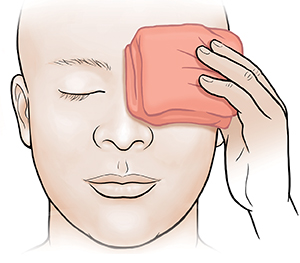Viral conjunctivitis is sometimes called pink eye. It's a common infection of the eye and is very contagious. Touching the infected eye and then touching another person spreads this infection. It can also be spread from one eye to the other in the same way. The most common symptoms include redness, discharge from the eye, swollen eyelids, and a gritty or scratchy feeling in the eye.
This condition usually takes about 7 to 10 days to go away. Artificial tears are often recommended to moisten and clean the eyes. This product is available without a prescription. Antibiotic eye drops often are not recommended because they don't kill viruses. There are times when antibiotics may be prescribed by health care providers to prevent a second, bacterial infection.
Home care
-
Apply a clean towel soaked in cool water to the affected eye 3 to 4 times a day (just before applying medicine to the eye).
-
It's common to have mucus drainage during the night, causing the eyelids to become crusted by morning. Use a clean warm, wet cloth to gently wipe this away.
-
Wash any cloths used to clean the eye after one use. Don't reuse them.
-
If you wear contact lenses, don't use them until your health care provider says it's okay. When you return to wearing them, use new lenses.
-
If antibiotic medicines are prescribed, take them exactly as directed. Don't stop taking them until you are told to do so.
-
You may use acetaminophen or ibuprofen to control pain, unless another medicine was prescribed. If you have chronic liver or kidney disease, talk with your provider before using these medicines. Also talk with your provider if you have ever had a stomach ulcer or gastrointestinal bleeding. Aspirin should never be used in anyone under 18 years of age who is ill. This is to prevent a serious illness called Reye syndrome. It may cause severe liver or brain damage.
-
Wash your hands before and after touching the affected eye. This helps to prevent spreading the infection to your other eye and to other people.
-
The infected person should not share towels, washcloths, and bedding with others. This is to prevent spreading the infection.
-
This illness is contagious during the first week. Children with this illness should be kept out of daycare and school until the redness clears.
Follow-up care
Follow up with your health care provider, or as advised.
When to get medical advice
Contact your health care provider right away if any of the following occur:
-
Vision gets worse
-
Eye pain gets worse
-
Swelling or redness of the eyelid gets worse
-
Redness spreads to the skin around the eye
-
Large amount of green or yellow crusting and drainage from the eye
-
Severe itching in or around the eye
-
Fever of 100.4°F (38°C) or higher, or as directed by your provider


